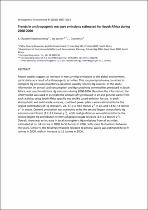 ResearchSpace
ResearchSpace
Trends in anthropogenic mercury emissions estimated for South Africa during 2000-2006
JavaScript is disabled for your browser. Some features of this site may not work without it.
- ResearchSpace
- →
- Research Publications/Outputs
- →
- Journal Articles
- →
- View Item
| dc.contributor.author |
Masekoameng, KE

|
|
| dc.contributor.author |
Leaner, J

|
|
| dc.contributor.author |
Dabrowski, James M

|
|
| dc.date.accessioned | 2012-05-09T09:41:44Z | |
| dc.date.available | 2012-05-09T09:41:44Z | |
| dc.date.issued | 2010-08 | |
| dc.identifier.citation | Masekoameng, KE, Leaner, J and Dabrowski, J. 2010. Trends in anthropogenic mercury emissions estimated for South Africa during 2000-2006. Atmospheric Environment, vol. 44(25), pp 3007-3014 | en_US |
| dc.identifier.issn | 1352-2310 | |
| dc.identifier.uri | http://www.sciencedirect.com/science/article/pii/S1352231010003791 | |
| dc.identifier.uri | http://hdl.handle.net/10204/5850 | |
| dc.description | Copyright: 2010 Elsevier. This is an ABSTRACT ONLY. | en_US |
| dc.description.abstract | Recent studies suggest an increase in mercury (Hg) emissions to the global environment, particularly as a result of anthropogenic activities. This has prompted many countries to complete Hg emission inventories, based on country-specific Hg sources. In this study, information on annual coal consumption and Hg-containing commodities produced in South Africa, was used to estimate Hg emissions during 2000-2006. Based on the information, the UNEP toolkit was used to estimate the amount of Hg released to air and general waste from each activity; using South Africa specific and toolkit based emission factors. In both atmospheric and solid waste releases, coal-fired power plants were estimated to be the largest contributors of Hg emissions, viz. 27.1 to 38.9 tonnes y1 in air, and 5.8 to 7.4 tonnes y1 in waste. Cement production was estimated to be the second largest atmospheric Hg emission contributor (2.2e3.9 tonnes y1), while coal gasification was estimated to be the second largest Hg contributor in terms of general waste releases (2.9e4.2 tonnes y1). Overall, there was an increase in total atmospheric Hg emissions from all activities, estimated at ca. 34 tonnes in 2000, to 50 tonnes in 2006, with some fluctuations between the years. Similarly, the total Hg emissions released to general waste was estimated to be 9 tonnes in 2000, with an increase to 12 tonnes in 2006. | en_US |
| dc.language.iso | en | en_US |
| dc.publisher | Elsevier | en_US |
| dc.relation.ispartofseries | Workflow;6933 | |
| dc.subject | Mercury emissions | en_US |
| dc.subject | Coal combustion | en_US |
| dc.subject | Coal consumption | en_US |
| dc.subject | Hg emissions | en_US |
| dc.subject | Power plants | en_US |
| dc.subject | Global change | en_US |
| dc.title | Trends in anthropogenic mercury emissions estimated for South Africa during 2000-2006 | en_US |
| dc.type | Article | en_US |
| dc.identifier.apacitation | Masekoameng, K., Leaner, J., & Dabrowski, J. M. (2010). Trends in anthropogenic mercury emissions estimated for South Africa during 2000-2006. http://hdl.handle.net/10204/5850 | en_ZA |
| dc.identifier.chicagocitation | Masekoameng, KE, J Leaner, and James M Dabrowski "Trends in anthropogenic mercury emissions estimated for South Africa during 2000-2006." (2010) http://hdl.handle.net/10204/5850 | en_ZA |
| dc.identifier.vancouvercitation | Masekoameng K, Leaner J, Dabrowski JM. Trends in anthropogenic mercury emissions estimated for South Africa during 2000-2006. 2010; http://hdl.handle.net/10204/5850. | en_ZA |
| dc.identifier.ris | TY - Article AU - Masekoameng, KE AU - Leaner, J AU - Dabrowski, James M AB - Recent studies suggest an increase in mercury (Hg) emissions to the global environment, particularly as a result of anthropogenic activities. This has prompted many countries to complete Hg emission inventories, based on country-specific Hg sources. In this study, information on annual coal consumption and Hg-containing commodities produced in South Africa, was used to estimate Hg emissions during 2000-2006. Based on the information, the UNEP toolkit was used to estimate the amount of Hg released to air and general waste from each activity; using South Africa specific and toolkit based emission factors. In both atmospheric and solid waste releases, coal-fired power plants were estimated to be the largest contributors of Hg emissions, viz. 27.1 to 38.9 tonnes y1 in air, and 5.8 to 7.4 tonnes y1 in waste. Cement production was estimated to be the second largest atmospheric Hg emission contributor (2.2e3.9 tonnes y1), while coal gasification was estimated to be the second largest Hg contributor in terms of general waste releases (2.9e4.2 tonnes y1). Overall, there was an increase in total atmospheric Hg emissions from all activities, estimated at ca. 34 tonnes in 2000, to 50 tonnes in 2006, with some fluctuations between the years. Similarly, the total Hg emissions released to general waste was estimated to be 9 tonnes in 2000, with an increase to 12 tonnes in 2006. DA - 2010-08 DB - ResearchSpace DP - CSIR KW - Mercury emissions KW - Coal combustion KW - Coal consumption KW - Hg emissions KW - Power plants KW - Global change LK - https://researchspace.csir.co.za PY - 2010 SM - 1352-2310 T1 - Trends in anthropogenic mercury emissions estimated for South Africa during 2000-2006 TI - Trends in anthropogenic mercury emissions estimated for South Africa during 2000-2006 UR - http://hdl.handle.net/10204/5850 ER - | en_ZA |





